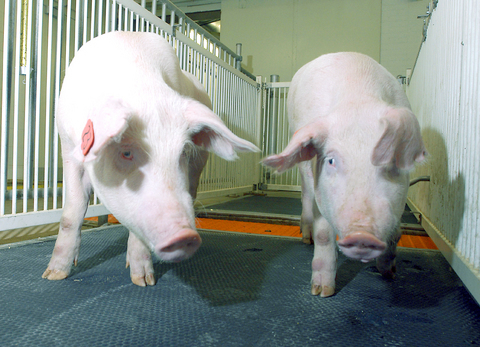A group of university researchers said Sunday that they had created what sounds like a nutritional holy grail: cloned pigs that make their own omega-3 fatty acids, potentially leading to bacon and pork chops that might help your heart.
For now, the benefits of the research are theoretical. Omega-3 fatty acids, which have been linked to a lowered incidence of heart disease, are primarily found in fish. No one knows whether they would have the same effect if people ate them in pork.
And government approval for such genetically modified foods is certain to face monumental opposition from some consumer groups. Some already object to feeding farm animals genetically modified grain, and genetically modifying the animals themselves and cloning them would be "a double whammy," said Joseph Mendelson, the legal director for the Center for Food Safety, a nonprofit group that opposes the use of genetically engineered products. "I am confident that consumers would not want them."

PHOTO: NY TIMES NEWS SERVICE
Still, some scientists say the findings, published online by the journal Nature Biotechnology, are an important forerunner of things to come. Although close to a dozen animals have been cloned in the decade since Dolly the sheep, using cloning to change the nutritional value of farm animals is groundbreaking.
"At this point, it's a new era," said Alice H. Lichtenstein, a professor of nutrition science and policy at the Gerald J. and Dorothy R. Friedman School of Nutrition Science and Policy at Tufts University School of Medicine.
Alexander Leaf, an emeritus professor of clinical medicine at Harvard, said he was confident that pork and other foods with omega-3s would eventually get to American consumers and that they would be better for it.
"People can continue to eat their junk food," Leaf said. "You won't have to change your diet, but you will be getting what you need."
For years, people have been urged to eat fish rich in omega-3 fatty acids. But fish can be expensive, not everyone likes it, and omega-3s are in greatest abundance in oily fish like tuna, which contains mercury.
That nutritional conundrum led a group of scientists from Harvard Medical School, the University of Missouri and the University of Pittsburgh Medical Center to think of modifying pigs.
What resulted was five white piglets with muscle tissue larded with omega-3 fatty acids. They live at the University of Missouri in individual pens with fiberglass-railed sides, concrete floors and black foam pads for beds.
Pigs with their own omega-3 fatty acids exist in nature, notably a Spanish breed called Iberico. But Jing X. Kang, an associate professor of medicine at Harvard Medical School and the lead author of the new paper, said pigs were only the beginning, adding that he was also developing cows that made omega-3s in their milk and chickens that had the fatty acids in their eggs.
It will be years before such products make their way to market, if ever. Michael Herndon, a spokesman for the Food and Drug Administration, said in an e-mail message that research with genetically engineered animals would probably require approval from the agency and that the FDA "also expects documentation of plans regarding the disposition of all investigational animals after their participation in the study is completed."
Herndon said the FDA had not yet approved any genetically modified animals for food.
Mendelson of the Center for Food Safety added that his group worried about the ability of the food and drug agency to determine the safety of genetically modified foods. And he said the cloning process could produce unhealthy animals.
Kang said the work began a few years ago when he put a gene for the production of omega-3 fatty acids into mice. Mammals do not have that gene; it is found instead in microorganisms, plankton, algae and worms, he said. Fish get the fatty acids by eating algae.
Kang used a gene from roundworms that converts an abundant form of fatty acid, omega-6, to omega-3. He had to modify the worm enzyme, making it into one that would function in mammals. Then he injected the gene for the enzyme into mouse embryos, some of which took it up, yielding mice that made their own omega-3s.
The next step was to create pigs with the enzyme. That work was done by Randall S. Prather, a pig cloning expert at the University of Missouri, who ended up with the five cloned pigs that had the gene in every cell of their bodies and made their own omega-3 fatty acids in their muscles.
Although pigs have been cloned before -- along with a growing list of animals, including sheep, mice, rats, cows, goats, rabbits, cats, a mule, a horse and a dog -- these are the first livestock to be cloned and genetically modified to make omega-3s.
Prather said the omega-3 pigs, born in November, will be bred when they reach puberty. Then, he said, "we will distribute them to researchers who are interested."

A vaccine to fight dementia? It turns out there may already be one — shots that prevent painful shingles also appear to protect aging brains. A new study found shingles vaccination cut older adults’ risk of developing dementia over the next seven years by 20 percent. The research, published Wednesday in the journal Nature, is part of growing understanding about how many factors influence brain health as we age — and what we can do about it. “It’s a very robust finding,” said lead researcher Pascal Geldsetzer of Stanford University. And “women seem to benefit more,” important as they’re at higher risk of

Eric Finkelstein is a world record junkie. The American’s Guinness World Records include the largest flag mosaic made from table tennis balls, the longest table tennis serve and eating at the most Michelin-starred restaurants in 24 hours in New York. Many would probably share the opinion of Finkelstein’s sister when talking about his records: “You’re a lunatic.” But that’s not stopping him from his next big feat, and this time he is teaming up with his wife, Taiwanese native Jackie Cheng (鄭佳祺): visit and purchase a

April 7 to April 13 After spending over two years with the Republic of China (ROC) Army, A-Mei (阿美) boarded a ship in April 1947 bound for Taiwan. But instead of walking on board with his comrades, his roughly 5-tonne body was lifted using a cargo net. He wasn’t the only elephant; A-Lan (阿蘭) and A-Pei (阿沛) were also on board. The trio had been through hell since they’d been captured by the Japanese Army in Myanmar to transport supplies during World War II. The pachyderms were seized by the ROC New 1st Army’s 30th Division in January 1945, serving

The People’s Republic of China (PRC) last week offered us a glimpse of the violence it plans against Taiwan, with two days of blockade drills conducted around the nation and live-fire exercises not far away in the East China Sea. The PRC said it had practiced hitting “simulated targets of key ports and energy facilities.” Taiwan confirmed on Thursday that PRC Coast Guard ships were directed by the its Eastern Theater Command, meaning that they are assumed to be military assets in a confrontation. Because of this, the number of assets available to the PRC navy is far, far bigger